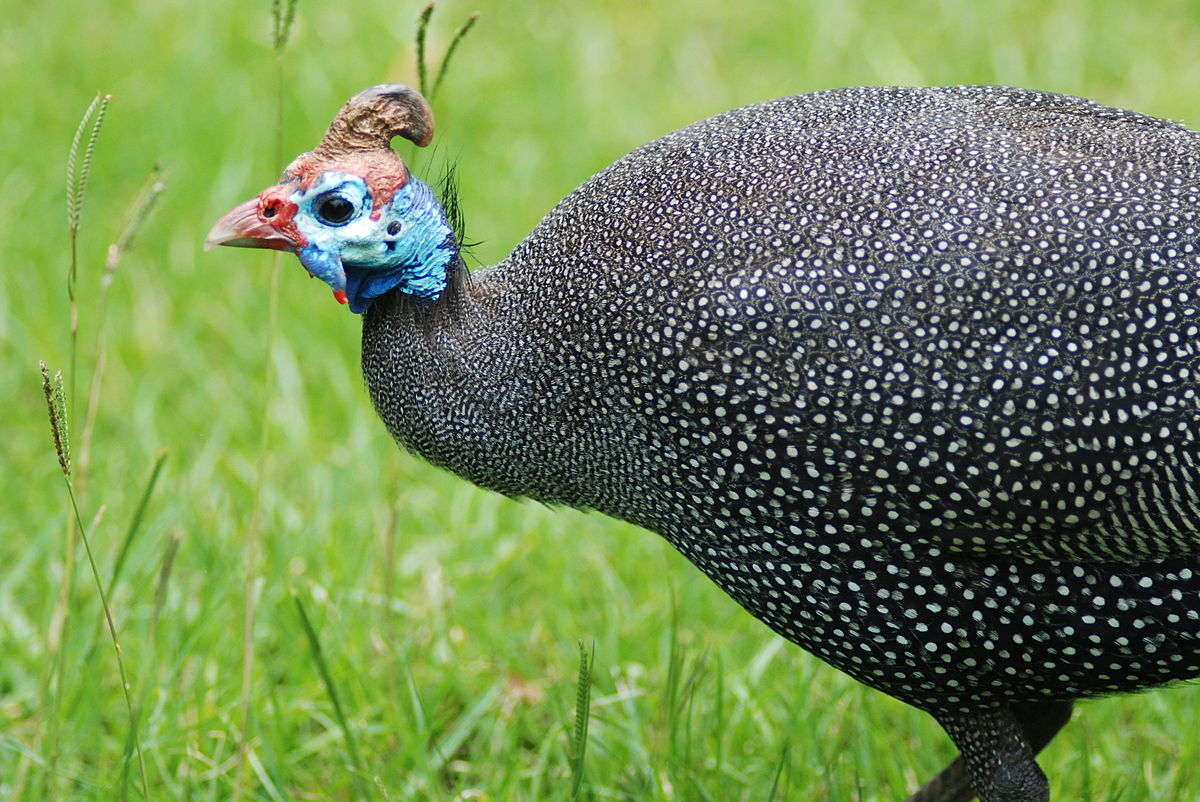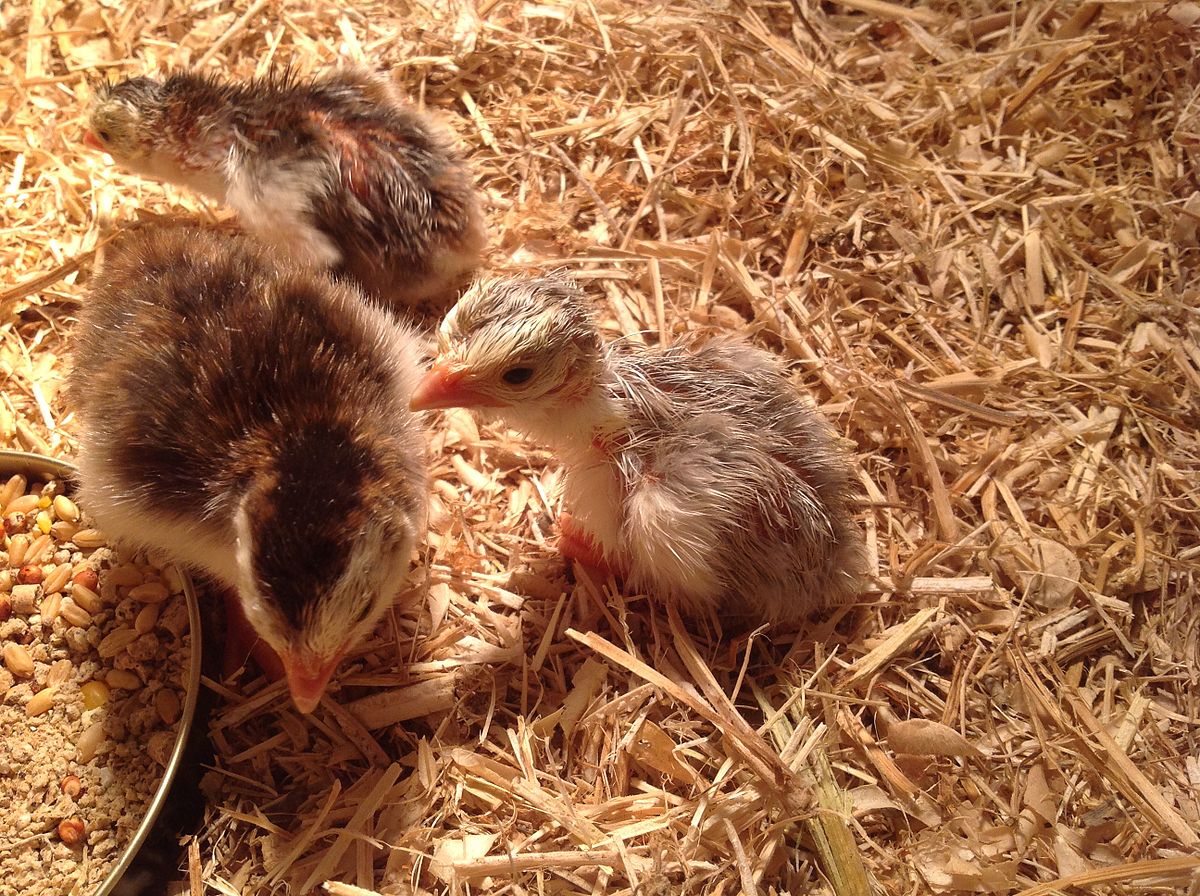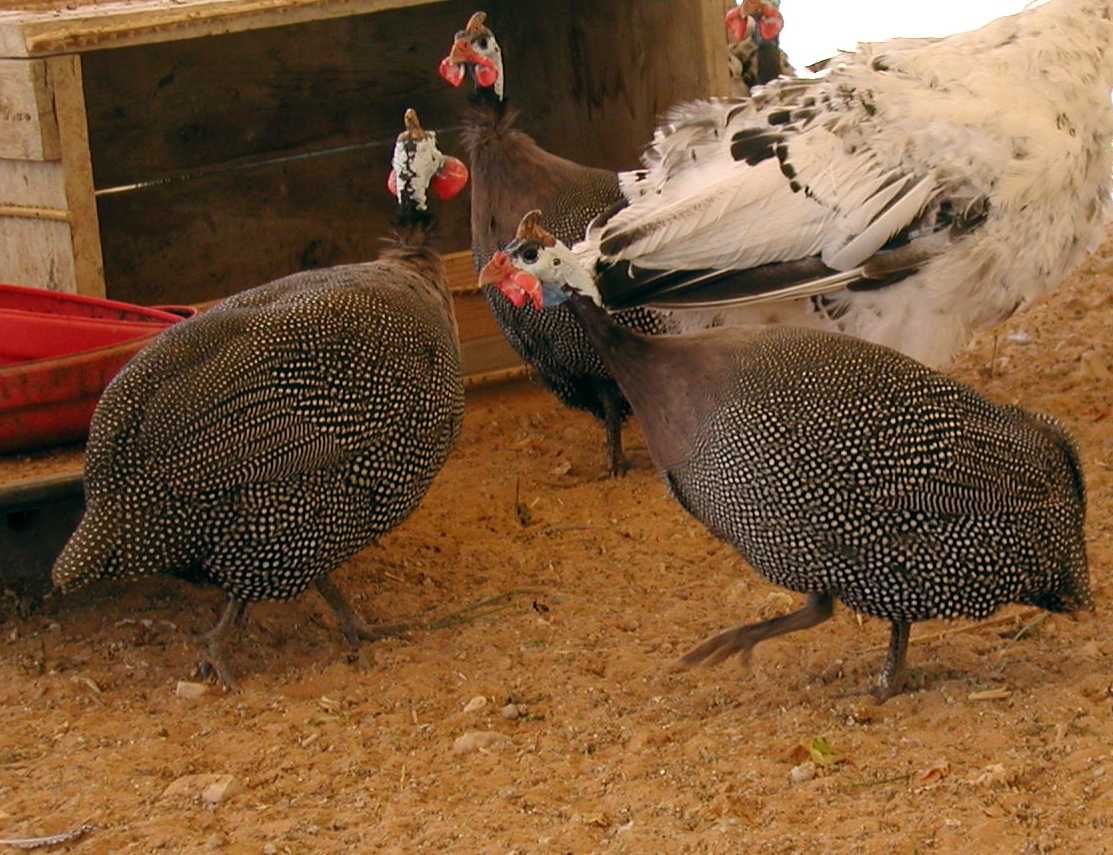This is the first animal profile I’ve written, to complement the plant profiles (of which I will post more, soon).
 Guinea fowl, specifically the common helmeted guinea fowl (Numida meleagris) are native to Africa, but have been widely introduced to other areas with similar climates. They’re not an uncommon sight on farms and rural properties in WA. As far as I can tell, the main reason is that they’re very, very good at controlling insect populations – including ticks and the various crop-destroying grasshoppers, locusts, and beetles. They also eat flies and maggots, so they help control the fly plagues we get at the beginning of most summers.
Guinea fowl, specifically the common helmeted guinea fowl (Numida meleagris) are native to Africa, but have been widely introduced to other areas with similar climates. They’re not an uncommon sight on farms and rural properties in WA. As far as I can tell, the main reason is that they’re very, very good at controlling insect populations – including ticks and the various crop-destroying grasshoppers, locusts, and beetles. They also eat flies and maggots, so they help control the fly plagues we get at the beginning of most summers.
We bought our first guinea fowl last year, in spring, as week-old keets (keet is the correct word for a baby guinea fowl, although ‘guinea fowl chick’ is usually self explanatory enough too). As baby keets, they’re slightly smaller than chickens of the same age, and totally adorable. They need a higher protein feed than chicks, around 23% rather than the 18% which works for laying chickens under 6 weeks old, so you need to use a game bird starter or turkey starter crumble.
And this was the first lesson. Beware: guinea fowl are creatures of habit; they are actually scared of new foods, so introduce a bit of whatever they’ll be eating as adults when they’re under 2 weeks old or expect them to freak out the first time they see it. Our original five are still terrified of the turkey pellets we bought to give them as a supplement to their free ranging insect-eating habit. They’re suspicious of the chicken scratch mix that we give them now, although they’ve seen the chickens eating it so they do eat it. Warily. Cautiously. As if it might, somehow, leap up and attack them.
At 6 weeks old, we moved the keets from the brooder (an old rabbit hutch, lines to keep draughts out, with a heat source for the babies) to their outside run, which we had temporarily roofed over with bird netting. This was a scary experience, and it took them a week to calm down about the terribly frightening sky. Kangaroos way over at the other end of the paddock still cause a noisy freak out at 5 am. And wow – when the chickens lay, and start their egg song, the guinea fowl add their loudest alarm to the noise in case the chickens have seen a predator that they haven’t noticed yet. Lesson number 2: when people say that guinea fowl are “a bit noisy”, what they mean is that they are louder than a tree full of cockatoos in pine-cone season, and will shriek and perform for about half an hour every time something frightens them. And they’re easily frightened.
A month later (it should have been 2 weeks, but we were busy), we removed the bird net from the run, leaving it open to the sky. This was itself a traumatic experience for the guinea fowl. Bird nets are more terrifying than kangaroos, apparently. The run is fox resistant, but, being open at the top it is not fox proof; we’re aware of that. The fence is 2m tall, and along the top we’ve attached a floppy extra section of wire, leaned outwards, to help discourage foxes and cats. So far, no predators have gotten in. Hopefully this means that it’s safe – but if there ever is a predator, we’ll know about it. Guinea fowl do not sleep as heavily as chickens. The other night one of our cats slipped out under my feet and dashed up to the guinea fowl run. I caught him and picked him up before he could get far, but the cat and I were pretty close to the edge of the run where the guineas were roosting (the top of the fence is their chosen sleeping place), and they spooked. Noisily. The five of them took off and spent the rest of the night in the trees, squawking periodically when they couldn’t find each other. Then they made a racket again at 5.30 (sunrise) when they woke up and weren’t together.
Lesson 3: guinea fowl have a very strong flocking instinct. They move like one creature. Sometimes (because they’re also very, very stupid) they get “trapped” with 2 on one side of the fence and 3 on the other, and then they run up and down along the fence together, making distress noises. The concept that they could, at any time, fly over the fence doesn’t seem to occur to them.
In spite of the noise, though, they’re funny birds, and they’re already doing their job of eating all the bugs which would otherwise be eating my trees. We have a particular problem with grasshoppers, which last summer decimated the trees and almost killed a couple’ve citrus. Worth having some guinea fowl around, if you have a large enough property and live rurally enough hat the noise won’t be a problem. We currently have just over a dozen eggs in the incubator, bought off of , so about a month from now we should have a new batch of keets hatching.

What guinea fowl need:
- Water – Guinea fowl are dry climate birds, and they don’t use much water, but they do need clean, fresh water to be available at all times – just like every other domesticated animal or bird does.
- Food – Where the natural diet of chickens is around 80% seeds and plants, 20% insects, the natural diet of guinea fowl is around 80% insects and 20% plants and seeds. Adult guinea fowl need more protein than chickens (around 18%, vs. around 15% for chickens), and keets need 24 – 26% protein. Always use an unmedicated feed for guinea fowl.
- Shelter – Guinea fowl are likely to roost in trees, but it’s good to provide them with perches in a sheltered, dry area. They will imprint on the place they’re raised as home, and if you give them a treat of some chicken scratch mix or millet every night, they’ll keep coming home – this can help you to protect them from foxes and other predators.
- Nesting Space – Guinea fowl lay seasonally, and they build their nests in a sheltered, private spot. Basically, just make some inviting looking corners available, and never remove all the eggs from a nest once you find it (or let them see you removing eggs), or they’ll move somewhere else.
- Space – Guinea fowl may range up to a km; you shouldn’t keep them at all unless you have several acres of land which they can range across. If you choose to keep them enclosed, allow about 1.5 sqm of outdoor space per bird as a minimum.
- Warmth – Adult guinea fowl will do fine in most weather, although they aren’t good in very cold areas (i.e. if it snows, they’re probably not the best choice). Keets need a heat source for the first 4 – 6 weeks, depending on the weather, starting at 37°C and gradually decreasing over the time.
What guinea fowl have to offer:
- Insect control – particularly ticks. Guinea fowl have also been known to kill rats and mice, and if there are enough of them they will gang up on a snake and kill it if they find one. This is instinctive – they don’t learn it from adult guinea fowl.
- Eggs – guinea fowl eggs are slightly smaller than chicken eggs, and are produced seasonally in spring and summer (not year round like chickens), but they are edible and tasty. Guinea fowl eggs have a richer flavour than chicken eggs. Or you can hatch them, and get more guinea fowl.
- More guinea fowl – eggs which are to be incubated should be put into the incubator within 7 days of being laid. They have the same temperature (36 -39°C, with best development at 38°C) and humidity requirements as chicken eggs, and must be turned 3 – 5 times per day to avoid the yolk sticking to the inside of the shell. Incubation time is approx. 28 days (compared to 21 for chickens).
- Meat – guinea fowl are a well known game bird, like quail and pheasant, and they are very good to eat. Kill and pluck them as you would a chicken. The adult bird is smaller than a chicken, and the meat is darker and leaner, but it tastes very good.
- Guano – guinea fowl manure is just as good as chicken (or seagull, or bat) manure for providing phosphorus and potassium to plants. It is high in nitrogen so it should be composted before use, or use sparingly.
- Guard services – guinea fowl will make a very loud noise if they encounter a predator or intruder, and as they flock with chickens they will act as an alarm if anything attacks your chickens as well.
Images sourced from Wikimedia Commons:
File:Helmeted_Guineafowl_in_the_Drakensberg_of_Natal.jpg
File:Guinea_fowl_keet_3.jpg
File:Helmeted_Guineafowl_and_a_cock.jpg